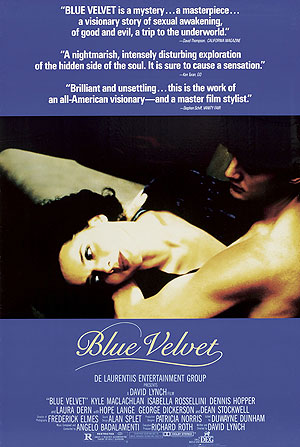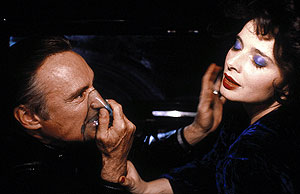
Blue Velvet

BLUE VELET (MOVIE)
De Laurentiis Entertainment Group
Original release: September 19th, 1986
Running time: 120 minutes
Writer and director: David Lynch
Composer: Angelo Badalamenti
Cast: Kyle MacLachlan, Isabella Rossellini, Dennis Hopper, Laura Dern, George Dickerson, Dean Stockwell

“My childhood was elegant homes, tree-lined streets, the milkman, building backyard forts, droning airplanes¸ blue skies, picket fences, green grass, cherry trees. Middle America as it’s supposed to be. But on the cherry tree there’s this pitch oozing out – some black, some yellow, and millions of red ants crawling all over it. I discovered that if one looks a little closer at this beautiful world, there are always red ants underneath.” – David Lynch, Lynch on Lynch ¹
Lynch’s recollection of his early youth touches on something we all go through growing up: the realisation there’s a big old world out there, and not everything and everyone is nice. There’s a chaos lurking beneath the surface, and no matter how much we attempt to maintain an illusion of (suburban) stability, a closer look will always reveal something best left unseen.
Blue Velvet is a film unafraid to expose the darker sides of society. In the opening scene, Lynch revisits his childhood memory of the ‘red ants’ with a very similar – and heavily symbolic – sequence. We’re presented with waving firemen, perfect rose bushes and pristine white fences. A man waters his lawn in the morning sun, until his hosepipe gets caught and knotted. Tugging at the hose, he suddenly experiences a heart attack and collapses. A dog barks at the wild water stream, and the camera slowly delves into the wet, green grass. As the giant blades brush past our view, we suddenly come across a crawling, repulsive mass of bugs and insects: the ever-present chaos just beneath the surface.
In Blue Velvet’s community of Lumberton, sexual deviant and murderer Frank Booth (Dennis Hopper) and his crew are the ‘red ants’ of this postmodern, idealised suburban town; a slowly revealed presence as we follow Jeffrey Beaumont (Kyle MacLachlan) – our young protagonist – along his descent into and eventual ascent from the dark criminal underworld lurking in his Middle American town.
Jeffrey has returned home to Lumberton to visit his hospitalised father – the man who collapses during the opening scene. After he stumbles upon a severed human ear in a field, he reports it to the local police. Intrigued by the event, Jeffrey decides to conduct his own investigation with the help of Sandy (Laura Dern), daughter of Police Detective Williams. Soon obsessed with a mysterious nightclub singer named Dorothy Vallens (Isabella Rossellini), Jeffrey gives in to temptation and infatuation, and is soon threatened by the local criminal gang, headed by the deplorable Frank.

According to Norman Denzin,
Yet, Blue Velvet presents us with much more than just a spotlight on the darker sides of society, as Lynch himself insistently points out in an interview with David Chute:
The film’s most interesting transformation is arguably that which takes place within Jeffrey’s mind – a process that enables the film to transcend it’s time period (although Lumberton is, quite literally, timeless – cars, fashion and technology span decades) and remain relevant as a coming-of-age story. During a memorable late-night exchange, Sandy says to Jeffrey, “I don’t know if you’re a detective or a pervert.” To which Jeffrey replies, “That’s for me to know and you to find out.”
Jeffrey exudes confidence, but we the audience know, just as well as he does, that this a question still unanswered in his own mind. This clean-cut college kid experiences a sexual and primal awakening at the hands of Dorothy Vallens; detective work quickly  (and unintentionally) becomes voyeurism as Jeffrey watches her undress from a closet. When caught, he enjoys their sexual encounter as she threatens him at knife point. In their subsequent meetings, Vallens begs Jeffrey to engage in sado-masochistic behaviour: “Hit me….hit me….”
(and unintentionally) becomes voyeurism as Jeffrey watches her undress from a closet. When caught, he enjoys their sexual encounter as she threatens him at knife point. In their subsequent meetings, Vallens begs Jeffrey to engage in sado-masochistic behaviour: “Hit me….hit me….”
When Jeffrey, giving in to Vallens’ demands and the sexual thrill, does finally hit her, he does so with such force that he chips one of her teeth. Ashamed and guilt-ridden, Jeffrey later weeps over the memory of his actions. By mimicking Frank’s behaviour, he unlocks a side of himself he clearly wishes had been left buried. This fear of ourselves is something Lynch clearly understands. After Frank kidnaps Jeffrey and drives him to the factory, he looks him dead in the eye: “You’re like me.” This is exactly what Jeffrey doesn’t want to hear.
The Jungian ‘shadow’ – the subconscious darker side of ourselves we attempt to hide – is a formidable presence throughout Lynch’s filmography. As Jung said, “Everyone carries a shadow, and the less it is embodied in the individual’s conscious life, the blacker and denser it is.” In Blue Velvet, the shadow is personified by Frank, and therefore Jeffrey must face him to regain control of his own psyche, overcome his darker side and redeem himself in time for Lynch’s purposefully clichéd Hollywood happy ending.
- [1] Rodley, Chris (Ed.). Lynch On Lynch. London: Faber and Faber Inc., 2005
- [2] Denzin, Norman K. ‘Blue Velvet: Postmodern Contradictions’, Theory Culture Society 5. Nottingham: Sage Publications, 1988
- [3] Chute, David. ‘Out to Lynch‘’, Film Comment 22, 1986
- [4] Jung, C.G. Collected Works 11. London: Routledge & Kegan Paul, 1958
Frank’s final moment leave a haunting impression. Determined to shoot Jeffrey, he starts to approach the closet in Dorothy Vallens’ apartment where our young protagonist is hiding; the very same spot from which Jeffrey watched Vallens undress earlier. Breaking the fourth wall (as Lynch’s antagonists so often do), Lynch puts the audience in Jeffrey’s point of view: we become him. Frank breathes in his mystery gas – which charges him up before acts of sex and violence – and looks straight out of the screen at us. Left with no option, Jeffrey raises his gun in an explosive moment of self-redemption.
Just as the red ants on the trees and the insects in the grass display a darker side of nature, Blue Velvet shows there is a darker side within even the most clean-cut of us. Human beings are capable of terrible things, and it takes less than you might think to unleash our inner shadows. This, I believe, is Blue Velvet’s most powerful message.


James Arden
James is a recent English Literature graduate from the University of York. During his time at university he took as many film-related modules as possible, balancing his studies of Dickens and Shakespeare with healthy doses of David Lynch and Orson Welles. He’s drawn to auteuristic and controversial filmmakers; a far-reaching interest that extends from the colourful, retroistic aesthetics of Wes Anderson to the disturbing yet engaging films of Lars von Trier. Somewhere inbetween lies a love for Polanski, Kubrick and P.T. Anderson.
James is also a filmmaker and film journalist. Follow his work on his website and follow him on Twitter @jnarden.
© 2022 STATIC MASS EMPORIUM . All Rights Reserved. Powered by METATEMPUS | creative.timeless.personal. | DISCLAIMER, TERMS & CONDITIONS
HOME | ABOUT | CONTACT | TWITTER | GOOGLE+ | FACEBOOK | TUMBLR | YOUTUBE | RSS FEED
CINEMA REVIEWS | BLU-RAY & DVD | THE EMPORIUM | DOCUMENTARIES | WORLD CINEMA | CULT MOVIES | INDIAN CINEMA | EARLY CINEMA
MOVIE CLASSICS | DECONSTRUCTING CINEMA | SOUNDTRACKS | INTERVIEWS | THE DIRECTOR’S CHAIR | JAPANESE CINEMA





